|
|
Why to retread?
The first and most important reason is: ECONOMY. Other reasons may be: resources optimization, recycling and environmental care.
How to retread?
Retreading is not just an industrial process. At DiMaggio, it is a culture!
It is necessary to keep into account the following:
- Take care of the tires during their first lives and during each retreading life.
- Keep the appropriate inflation pressure.
- Do not overload them.
- Do not exceed the shifting speed they were manufactured for.
- Adjust the wheels appropriately according to their sizes.
- Perform dual assembly.
- Take them off the vehicles before they present sailcloth or exposed belts.
- Check the good conditions of the flanges.
- Select the appropriate design depending on the work the vehicle will perform.
|
| RETREADING TYRES PROCESS |
| Productive process of retreading tiyes for trucks and bus. |
| 1 of 10 - RECEPTION |
| The tyres reception is the beginning of the process. |
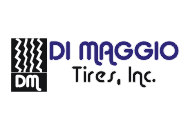 |
This activity is made in the Reception Area, where tyres are checked by the industry supervisor to bear out that they are identified with the Order Number, the tyre position in the order and the client initials. |
 |
Once they are checked, the main inspector rewrites the tires identification with yellow panting... |
 |
... and they are carried to the soon-checked tyre zone, they are classified and temporary stored until they are taken to the initial inspection area. |
| 2 of 10 - INITIAL CHECK OUT |
| The initial check out is considered the most important part of the process, because over the half of the failures in retreading tyres are caused by a negligent initial inspection. In this area it is decided if the tyre can be retreaded or not. |
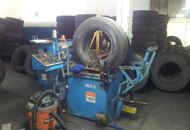 |
To perform this activity, the operator must indicate with yellow chalk the existent damages on the tyre following the fixing codes, in order to guide the activities that proceed in the detected flaws. |
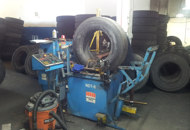 |
If the tyre is very worn down o if it has exposed canvas, it is rejected automatically. |
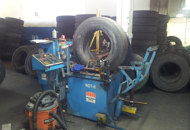 |
After this inspection, it is taken to the zone of tyres in process and it is stored temporary until it has to be taken to the scratching zone. |
| 3 of 10 - BUFFERING |
| It consists on eliminating all the residual, dirt and design of the tread. |
 |
Thanks to the Oliver buffering machine, an even surface with particular features is achieved and it ensures the tyre long service life. |
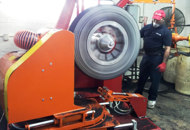 |
In order to perform this activity, the buffer must take into account the optimal conditions of the machine so that an excellent scratching process can be guaranteed. |
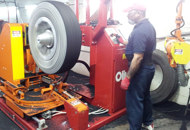 |
If the buffer machine is worn down, they cause too much friction and high temperatures, which originate certain degradation on the scratched surface. Besides, some specifications and parameters must be controlled for avoiding the damage of the belt joining. |
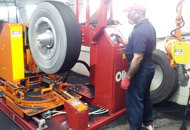 |
The buffer must indicate the tyre length and the beltdesign on one side of it with yellow chalk and take it to the rectifying area. |
| 4 of 10 - RECTIFYING |
| It consists on cleaning the zones where some flaws exist (punctures) and where the scratching machine cannot reach because of security measures. It is a final complement to the scratching process in order to guarantee the surface uniformity before cementing. |
 |
During the rectifying process, some diggings are performed if necessary in certain areas... |
 |
... the exposed strings are cut out, with a tool called Motor Tool, where some special pieces are placed to dig, bearing in mind the type of tyre construction (radial or conventional). |
 |
Once the rectifying process is finished, the tyre is taken to the fixing area in case of presenting deep punctures, or it may be taken to the cementing area directly. |
| 5 of 10 - FIXING |
| It consists on the removal, filled out and effort of the tyre damage... |
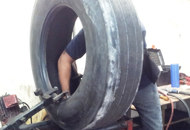 |
... either for superficial fixing, nail hole, reinforcing or section fixing. |
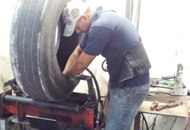 |
In this area a patch is placed on the tyre damaged side, depending on the size of the hole. |
| 6 of 10 - CEMENTING |
| It consists on cleaning the tyre external surface with a wire brush to guarantee there are no spots without cementing left. |
 |
Then, the tyre zone, where the cushion and the new tread are going to be put, will be coated with cement using a pressure gun or a paintbrush. |
 |
The required time for the cement to evaporate varies from fifteen to thirty minutes. It is important to point out that the cemented surface must not be touched, because the pre-printed belt might not be joined. |
 |
After passing the necessary time for the cement to dry, the tyre is taken to the filling and cushioning area. |
| 7 of 10 - FILLING AND CUSHIONING |
| This procedure consists on covering every fissure or dig presented in the cemented zone with cushion foam using a special gun. |
 |
The cushion foam is fixed to the tire using a grooved roller in order to level the filled surface and allow the tread not to present deformations. |
 |
The precured system (cool) is taken to the Precured Treading Area where the cushion and the pre-printed tread will be located, using an Oliver treading machine. |
| 8 of 10 - PRECURED BELTING |
| This procedure consists on setting the pre-printed belt. |
 |
In order to perform this task, the Oliver belting machine is used. |
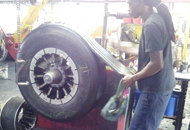 |
The operator must make sure that the belt is very well joined to the tyre. |
| 9 of 10 - VULCANIZING |
| This process is performed in a machine called SelfKey. |
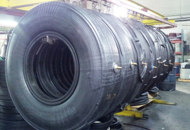 |
SelfKey machine. |
 |
The tyre is prepared to be vulcanized, which consists on putting a cover or envelope (external), then an innerlop (internal) to guarantee an even distribution of the pressure and temperature. Next, the tyre is taken to the final inspection area. |
| 10 of 10 - FINAL INSPECTION |
| An external and internal tyre inspection is performed in this area, looking for some flaws that may justify the rejection of the tyre. |
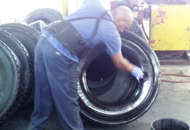 |
If it is rejected, the cause of the flaw is verified. On the contrary, the tyre is taken to the retreading tyre zone. |
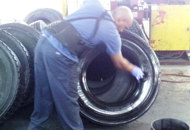 |
The tyre is painted in black and remains there until it is sold. |
|